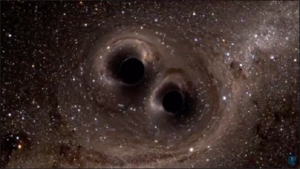Gravitational Waves – A new Science milestone
Sakshi Education
Gravitational Waves were the last prediction of Albert Einstein’s theory of relativity. The first direct detection of gravitational waves was announced on 11 February by the Advanced Laser Interferometer Gravitational-Wave Observatory (LIGO).


Using LIGO's twin giant detectors — one in Livingston, Louisiana, and the other in Hanford, Washington — researchers measured ripples in space-time produced by a collision between two black holes.
This is the first major detection by LIGO experiments after more than a decade in operation. The new discovery is truly incredible science and marks three milestones for physics:
Importance of Gravitational Waves
About gravitational waves
The denser the mass is, the greater the curvature of space-time. As objects with mass move around in space-time, the curvature also changes to the trail of the moving masses. At times accelerating objects generate changes in this curvature, which propagate outwards in a wave-like manner.
These propagating phenomena are known as gravitational waves. These are outflowing fluctuations of expanding and contracting space time. Not all movements create Gravitational waves; you need to change the Quadruple moment of a mass distribution.
Simply put it means motion should not be perfectly spherically symmetric or cylindrical symmetric.
But two objects orbiting each other in a planar orbit such as a planet orbiting the Sun or a binary star system or merging of two black holes will radiate Gravitational waves! LIGO have detected signals of gravitational waves from two merging black holes 1.3 billion light years, i.e. 1.3 billion years ago
These G-waves propagate at the speed of light, unlike the Newtonian gravity which propagates at infinite speed. This speed limit comes from the fact that speed of light is built into Einstein’s field equations. Therefore, for all massless things this is the ultimate speed limit.
Since G-waves are distortions in space-time, if it passes through a free standing body, the body may experience rhythmic stretching or shortening, without an unbalanced external force
But man may not even notice this stretching, one reason being that these stretching are negligibly miniscule, other reason, everything equally gets stretched, relatively the effect will be null.
But there is one constant in the universe that is absolute, i.e. the speed of light ‘c’, LIGO uses this property of Light(LASER) to measure minute changes in the space time continuum.
The precision that LIGO requires for this kind of detection can be compared to measuring the distance between Milky Way and Andromeda galaxy (2.5 million Light years away) to the scale of the width of a hair.
Gravitational waves carry energy away from their sources and, in the case of orbiting bodies, this is associated with an inspiral or decrease in orbit.
Higher acceleration generates powerful gravitational waves, since these huge systems generating g-waves are millions of light years away; the power that reaches on earth is minuscule.
Orbital lifetimes of binary systems which have high acceleration are one of the most important properties of gravitational radiation sources. It determines the average number of binary stars in the universe that are close enough to be detected.
Short lifetime binaries, i.e. systems which have imminent merger/collapse are strong sources of gravitational radiation but are few in number. Long lifetime binaries are more plentiful but they are weak sources of gravitational waves.
LIGO is most sensitive in the frequency band where binary systems are about to inspiral, i.e. about to merge. Inspirals are very important sources of gravitational waves.
Any time two objects such as white dwarfs, neutron stars, or black holes are in close orbits, they send out intense gravitational waves. As they spiral closer to each other, these waves become intense.
At some point they should become so intense that direct detection by their effect on objects on Earth is possible.
This time frame is only a few seconds. LIGO achieved sensitivities to detect such a microscopic blip in the cosmic noise after a multiyear shut down and an upgrade.
G- Waves can pass through any intervening matter without being scattered significantly. Whereas light from distant stars may be blocked out by interstellar dust, for example, gravitational waves will pass through essentially unimpeded.
This feature allows G-Waves to carry information about astronomical phenomena never before observed by humans. With this detection we will be able to turn the Universe into our own laboratory.
There are many things that we cannot replicate on Earth, like the dense cores of neutron stars, strangeness of a black hole singularity or event horizon. Under extreme conditions like this, nuclear physics and thermodynamics can theoretically do some interesting things.
Gravitational wave astronomy’s finest moment is also India’s.
Inter-University for Astronomy and Astrophysics (IUCAA) is one of 15 institutes in the country associated with the LIGO project. IUCAA and the Raman Research Institute (RRI), Bangalore, have made significant contribution in the analysis of the LIGO data.
The detection was also contributed to by Indian Initiative in Gravitational Wave Observations (INDIGO).
This is the first major detection by LIGO experiments after more than a decade in operation. The new discovery is truly incredible science and marks three milestones for physics:
- Direct detection of gravitational waves.
- The first detection of a binary black hole system.
- The most convincing evidence to date that nature’s black holes are the objects as predicted by Einstein’s theory.
Importance of Gravitational Waves
- To understand about gravitational waves, a brief backgrounder of the concept of gravity is required.
- According to Newtonian physics gravity is a force which makes two bodies with mass attracts each other.
- Einstein in the year 1915, with his radical general theory of relativity, gave a complete new perspective of gravity.
- The concept is mathematical and quite sophisticated, but can be defined simply as “Matter curves space and objects responds to that curvature.” i.e. Gravity is not a force as such, but a curvature caused in the space time fabric due to the presence of an object with mass.
- To visualize it, imagine a ball in a stretched rubber sheet, the presence of the ball causes a dip to form and the sheet curves depending on the weight of the ball, now another smaller ball, if rolled to the bigger ball follows the curved space. Roughly this is how earth revolves around the sun. Even though this analogy is not true cent percent, for visualization this will suffice.
- General theory of relativity makes prediction far beyond the familiar gravity. Few of them are; Time Dilation, in distinct but similar manner mass distorts the time too. Flow of time changes w.r.t the proximity of mass. The time that one experience near to sun is vastly different from that one do on earth. Deflection of light that we see - Gravitational Lensing.
- Dragging of space time by spinning objects- Frame Dragging. The beauty of Einstein’s work lay on the fact that each one of his predictions are physically tested and verified. There was one last incredible prediction which was never directly observed, i.e. Gravitational waves.
About gravitational waves
The denser the mass is, the greater the curvature of space-time. As objects with mass move around in space-time, the curvature also changes to the trail of the moving masses. At times accelerating objects generate changes in this curvature, which propagate outwards in a wave-like manner.
These propagating phenomena are known as gravitational waves. These are outflowing fluctuations of expanding and contracting space time. Not all movements create Gravitational waves; you need to change the Quadruple moment of a mass distribution.
Simply put it means motion should not be perfectly spherically symmetric or cylindrical symmetric.
- A spinning disk will not radiate. This can be regarded as a consequence of the principle of conservation of angular momentum.
- An isolated non-spinning solid object moving at a constant velocity will not radiate. This can be regarded as a consequence of the principle of conservation of linear momentum.
But two objects orbiting each other in a planar orbit such as a planet orbiting the Sun or a binary star system or merging of two black holes will radiate Gravitational waves! LIGO have detected signals of gravitational waves from two merging black holes 1.3 billion light years, i.e. 1.3 billion years ago
These G-waves propagate at the speed of light, unlike the Newtonian gravity which propagates at infinite speed. This speed limit comes from the fact that speed of light is built into Einstein’s field equations. Therefore, for all massless things this is the ultimate speed limit.
Since G-waves are distortions in space-time, if it passes through a free standing body, the body may experience rhythmic stretching or shortening, without an unbalanced external force
But man may not even notice this stretching, one reason being that these stretching are negligibly miniscule, other reason, everything equally gets stretched, relatively the effect will be null.
But there is one constant in the universe that is absolute, i.e. the speed of light ‘c’, LIGO uses this property of Light(LASER) to measure minute changes in the space time continuum.
The precision that LIGO requires for this kind of detection can be compared to measuring the distance between Milky Way and Andromeda galaxy (2.5 million Light years away) to the scale of the width of a hair.
Gravitational waves carry energy away from their sources and, in the case of orbiting bodies, this is associated with an inspiral or decrease in orbit.
Higher acceleration generates powerful gravitational waves, since these huge systems generating g-waves are millions of light years away; the power that reaches on earth is minuscule.
Orbital lifetimes of binary systems which have high acceleration are one of the most important properties of gravitational radiation sources. It determines the average number of binary stars in the universe that are close enough to be detected.
Short lifetime binaries, i.e. systems which have imminent merger/collapse are strong sources of gravitational radiation but are few in number. Long lifetime binaries are more plentiful but they are weak sources of gravitational waves.
LIGO is most sensitive in the frequency band where binary systems are about to inspiral, i.e. about to merge. Inspirals are very important sources of gravitational waves.
Any time two objects such as white dwarfs, neutron stars, or black holes are in close orbits, they send out intense gravitational waves. As they spiral closer to each other, these waves become intense.
At some point they should become so intense that direct detection by their effect on objects on Earth is possible.
This time frame is only a few seconds. LIGO achieved sensitivities to detect such a microscopic blip in the cosmic noise after a multiyear shut down and an upgrade.
G- Waves can pass through any intervening matter without being scattered significantly. Whereas light from distant stars may be blocked out by interstellar dust, for example, gravitational waves will pass through essentially unimpeded.
This feature allows G-Waves to carry information about astronomical phenomena never before observed by humans. With this detection we will be able to turn the Universe into our own laboratory.
There are many things that we cannot replicate on Earth, like the dense cores of neutron stars, strangeness of a black hole singularity or event horizon. Under extreme conditions like this, nuclear physics and thermodynamics can theoretically do some interesting things.
Gravitational wave astronomy’s finest moment is also India’s.
Inter-University for Astronomy and Astrophysics (IUCAA) is one of 15 institutes in the country associated with the LIGO project. IUCAA and the Raman Research Institute (RRI), Bangalore, have made significant contribution in the analysis of the LIGO data.
The detection was also contributed to by Indian Initiative in Gravitational Wave Observations (INDIGO).
Published date : 15 Feb 2016 12:44PM













